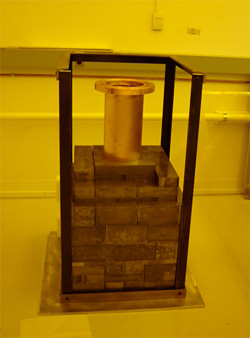
FACT SHEET: Click here to download PDF.
NAME: Dark Matter In CCDs, or DAMIC
The ORIGIN OF THE NAME: DAMIC searches for dark matter using Charge Coupled Devices. These digital chips register light that gets converted into a digital value a computer can store.
WHAT WILL THIS TELL? Everything you see, visible matter, makes up 4 percent of the universe. Dark matter and dark energy make up the rest of the universe. Physicists understand that dark matter acts as an invisible source of gravity, but little more.
DAMIC seeks to pinpoint what particles make up dark matter, which will help explain how the universe came to exist. Without the added gravitational attraction of dark matter, stars and galaxies would have never formed. The expansion of the universe after the Big Bang would have dispersed visible matter too quickly.
WHY IS THIS EXPERIMENT NEEDED NOW? Physicists have narrowed the hunt for the particles that constitute dark matter to neutral particles that interact very weakly with other matter particles. Only this type of particle fits with the way the universe evolved and its matter density. Recent results from other experiments, including DAMA/Libra and CoGeNT, suggest that dark matter particles are light weight, which fits DAMICís detection design.
WHAT IS DAMIC LOOKING FOR? A snapshot of the electrical charge created by a light-weight dark matter WIMP particle colliding with a camera computer chip.
FUNDED BY: DOE
NUMBER OF COLLABORATORS: Seven
U.S. COLLABORATING INSTITUTIONS: One national laboratory and three high schools
NON-US COLLABORATING INSTITUTIONS: Two universities (Paraguay and Brazil)
STATUS: Started taking data in mid-2009; improved the detector in June 2010.
LIFESPAN OF EXPERIMENT: One year. Collaborators then hope to upgrade to 10 CCDs and move to a deeper laboratory.
PHYSICS FRONTIER EXPLORING: Cosmic Frontier
FUN FACTS:
- The heart of your digital camera uses the same, though less high-quality, technology as the DAMIC CCDs.
- DAMIC saved $200,000 by using the electronics and a CCD originally developed for the Dark Energy Camera, DECam.
- Two Illinois high school students and one Baltimore high school teacher joined the collaboration.
- Recycled parts from other experiments at Fermilab comprised the first detector.
- The detector, without protective shielding, weighs 1 gram.
HOW DOES IT WORK? A dark matter WIMP particle would collide with an atom in a pixel inside a 6-cm long computer chip, such as the one in your digital camera, called a charged coupled device, or CCD. In a domino-like fashion, the ensuing secondary particles created by the collision would produce a muon that the CCD converts into electrons that get converted into a digital value a computer can store.
To keep other particles from getting to the CCD and being falsely interpreted as a dark matter particle, DAMICís design follows the model of a wooden Russian doll. The CCD is kept in a copper box placed in a copper tube surrounded by 10 tons of lead shielding blocks inside a larger dust-free container. The entire contraption is kept at minus 238 degrees Fahrenheit in the NuMI tunnel 350 feet underground.
WHAT MAKES THE EXPERIMENT UNIQUE? No one has used CCDs before to search for dark matter underground. The minimal amount of electronic static from using camera computer chips, CCDs, allows DAMIC to search for low-mass dark matter particles whose interactions produce only a small energy deposit on the detectors. This allows DAMIC to detect dark matter particles with masses of less than a proton or two. This allows DAMIC to detect collisions with dark matter particles that are eight times less energetic than those seen by any other experiment.
HOW DOES THIS FIT INTO FERMILABíS STRATEGIC PLAN? Fermilab scientists search for dark matter WIMPs using four different technologies: Charge Coupled Devices (DAMIC), bubble chambers (COUPP), cryogenic crystals (CDMS) and liquid argon (Darkside).
WHO IS THE MAIN COMPETITION? CoGent at the University of Chicago